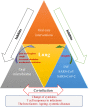Oral Microbiome and SARS-CoV-2: Beware of Lung Co-infection
- PMID: 32849438
- PMCID: PMC7411080
- DOI: 10.3389/fmicb.2020.01840
Oral Microbiome and SARS-CoV-2: Beware of Lung Co-infection
Abstract
The new coronavirus SARS-CoV-2, the cause of COVID-19, has become a public health emergency of global concern. Like the SARS and influenza pandemics, there have been a large number of cases coinfected with other viruses, fungi, and bacteria, some of which originate from the oral cavity. Capnocytophaga, Veillonella, and other oral opportunistic pathogens were found in the BALF of the COVID-19 patients by mNGS. Risk factors such as poor oral hygiene, cough, increased inhalation under normal or abnormal conditions, and mechanical ventilation provide a pathway for oral microorganisms to enter the lower respiratory tract and thus cause respiratory disease. Lung hypoxia, typical symptoms of COVID-19, would favor the growth of anaerobes and facultative anaerobes originating from the oral microbiota. SARS-CoV-2 may aggravate lung disease by interacting with the lung or oral microbiota via mechanisms involving changes in cytokines, T cell responses, and the effects of host conditions such as aging and the oral microbiome changes due to systemic diseases. Because the oral microbiome is closely associated with SARS-CoV-2 co-infections in the lungs, effective oral health care measures are necessary to reduce these infections, especially in severe COVID-19 patients. We hope this review will draw attention from both the scientific and clinical communities on the role of the oral microbiome in the current global pandemic.
Keywords: SARS-CoV-2; co-infection; influenza; microaspiration; oral care; oral microbiome.
Copyright © 2020 Bao, Zhang, Dong, Zhao, Li and Sun.
Figures

References
-
- Ai J.-W., Zhang H.-C., Xu T., Wu J., Zhu M., Yu Y.-Q., et al. (2020). Optimizing diagnostic strategy for novel coronavirus pneumonia, a multi-center study in Eastern China. medRxiv [Preprint] 10.1101/2020.02.13.20022673 - DOI
-
- Ardizzoni A., Pericolini E., Paulone S., Orsi C. F., Castagnoli A., Oliva I., et al. (2018). In vitro effects of commercial mouthwashes on several virulence traits of Candida albicans, viridans streptococci and Enterococcus faecalis colonizing the oral cavity. PLoS One 13:e0207262. 10.1371/journal.pone.0207262 - DOI - PMC - PubMed
Publication types
LinkOut - more resources
Full Text Sources
Other Literature Sources
Miscellaneous

